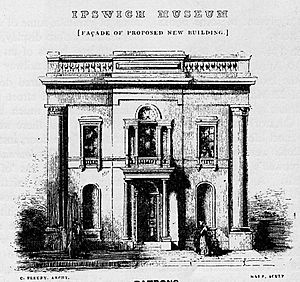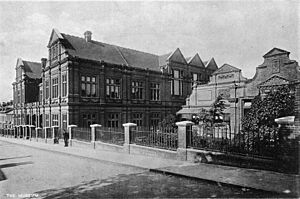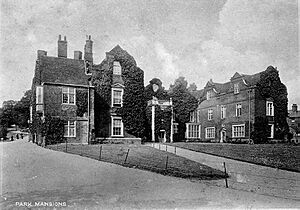Ipswich Museum facts for kids
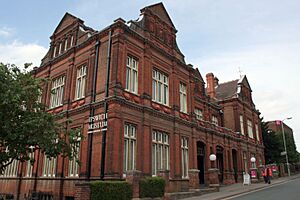 |
|
| Established | 1846 |
|---|---|
| Location | High Street, Ipswich, IP1 3QH |
The Ipswich Museum is a cool place to explore culture, history, and nature! It's located in a special old building on High Street in Ipswich, a town in Suffolk, England. For a long time, it was the most important museum in Suffolk, holding amazing collections from all over the county.
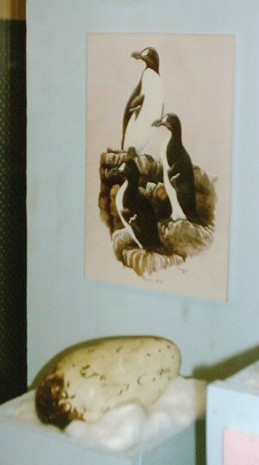
The museum first opened in 1846, mainly focusing on natural history. It moved to its current home on High Street in 1881. Later, around 1895, a big 16th-century house called Christchurch Mansion was given to the town. This mansion became a second part of the museum, showing off beautiful art and decorative items. Both places are managed together and share many of the same collections.
In 2007, the Ipswich Museum joined forces with the museum in Colchester, forming the Colchester + Ipswich Museums service. This means they work together to share their amazing collections and knowledge! The museum closed its doors in October 2022 for a big renovation project, which is expected to last about three years.
Contents
Discovering the Museum's Past
How It All Began: 1846–1853
The Ipswich Museum first opened in December 1847 on Museum Street. Its main goal was to teach working-class people about natural history. A group of people ran it, and they even had open evenings for the public to visit. The first president was a famous insect expert named William Kirby.
A kind person named George Ransome, from a well-known Ipswich family, started this project. Many important scientists supported the museum, wanting to help improve society through learning.
A Famous President: John Stevens Henslow, 1850–1861
The museum became nationally famous under its second president, Professor John Stevens Henslow. He was actually Charles Darwin's teacher at Cambridge University! In 1851, Prince Albert, the Queen's husband, visited the museum and loved it so much that he became its official patron.
The natural history displays, some of which you can still see today, were set up before Darwin published his famous book, The Origin of Species. These displays helped people understand the natural world as scientists knew it then. Many of the scientists involved with the museum were at the heart of the big changes happening in how people understood nature.
The Town Takes Over: 1853
After some money troubles in 1852, the people of Ipswich voted to support the museum using public funds. This meant the town's government took over running the museum. They made it much easier for everyone to visit. Professor Henslow continued to lead and grow the collections until 1861.
New Leaders and Discoveries: 1872–1893
After Henslow, Dr. John Ellor Taylor became the curator. He was a botanist (plant expert) and geologist (rock and earth expert). With help from Edward Packard, who started a fertilizer company, Taylor built one of the best collections of local geology in the country.
Dr. Taylor was also a popular science writer and gave many lectures, often for free, to large audiences. He even traveled to Australia to give talks! His work helped many people in Ipswich learn about science.
A Brand New Building: 1881
By 1880, the museum had so many collections and was so popular that it needed a bigger home. People from all over Suffolk helped raise money to build a new place for the museum and for art and science schools. The main supporter was Sir Richard Wallace, who created the famous art collection at Hertford House.
The new museum opened in 1881. It had a large hall with balconies, displaying many of the original exhibits. More new galleries and rooms were added between 1890 and 1900.
Expanding Collections: Frank Woolnough, 1893–1920
Frank Woolnough became the curator in 1893. In 1895, Christchurch Mansion, a beautiful Tudor house, was given to the town. Woolnough helped turn it into the art and local history part of the museum. He was very good at many subjects and helped both parts of the museum grow.
During this time, the study of archaeology (the study of human history through digging up old things) became very important in Ipswich. People like Nina Frances Layard made huge contributions. She was one of the first women to become a Fellow of the Society of Antiquaries of London and gave most of her collections to the Ipswich Museum.
The museum also got some amazing new items. The Ogilvie family donated a large collection of stuffed British birds in 1918. These birds are still on display and look incredible, showing how they lived in their natural homes. Other cool additions included gorillas, a stuffed giraffe, and a rhino nicknamed 'Gladys' or 'Rosie' by local schoolchildren!
The Sutton Hoo Connection: Guy Maynard, 1920–1952
Guy Maynard took over as curator in 1920. He and James Reid Moir worked together to develop the museum's archaeology work, digging up sites across Suffolk.
A very exciting event happened during Maynard's time. In 1938, the museum helped a local archaeologist named Basil Brown investigate some ancient mounds at Sutton Hoo. In 1939, he made an incredible discovery: a buried Anglo-Saxon ship and its amazing treasure! This find was so important that it attracted national attention.
During World War II, Guy Maynard had the big job of carefully packing away the most valuable collections to keep them safe. After the war, he brought them all back. Basil Brown continued his archaeological work for the museum until the 1960s, helping to build a record of historical sites in the county.
Museum Presidents
Many important people have served as honorary presidents of the Ipswich Museum over the years, including:
- The Revd. William Kirby, 1847–50
- The Revd. Professor John Stevens Henslow, 1850–1861
- Sir Richard Wallace, Bt, 1874–1890
- Sir Ray Lankester, 1901–1921
- James Reid Moir, F.R.S., 1921–1944
- Sir Charles Sherrington, 1944–1952
How the Museum Works Today
Over the years, the museum's team has changed to meet new needs and budgets. In 1974, the local government changed, and the museum's archaeology work moved to the new Suffolk County Council Field Archaeology Unit. The museum's links with the Ipswich Art School and Library also changed.
Joining Forces with Colchester Museum Service, 2007
On April 1, 2007, the Ipswich Museum joined with the Colchester Borough Council Museums Service. This created the Colchester + Ipswich Museums (CIMS). Even though the staff now work for CIMS, the museum building and its collections still belong to the town of Ipswich. Ipswich Borough Council helps fund 50% of the service.
CIMS has special curators and teams in Ipswich to care for the Ipswich Museum, Christchurch Mansion, and the Ipswich Art Gallery. Other teams work across both Ipswich and Colchester. A committee of councillors from both towns oversees the museum service.
Exciting Renovations!
Since 2022, the museum has been undergoing a huge renovation project costing £8.7 million! Some groups were worried about how the changes might affect the old-fashioned look of the museum. However, the museum staff have promised to keep the special Victorian feel of its Natural History Gallery. This means when it reopens, it will be a fantastic mix of old and new!
Amazing Things to See
The museum has many incredible items. While the famous Ipswich Hoard (a collection of ancient gold necklaces found nearby) is now in the British Museum, you can see copies of these amazing treasures right here in Ipswich!



